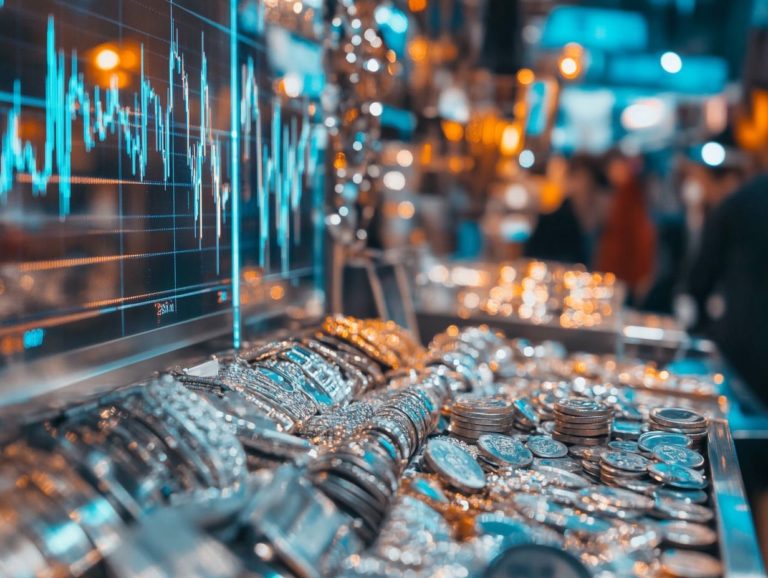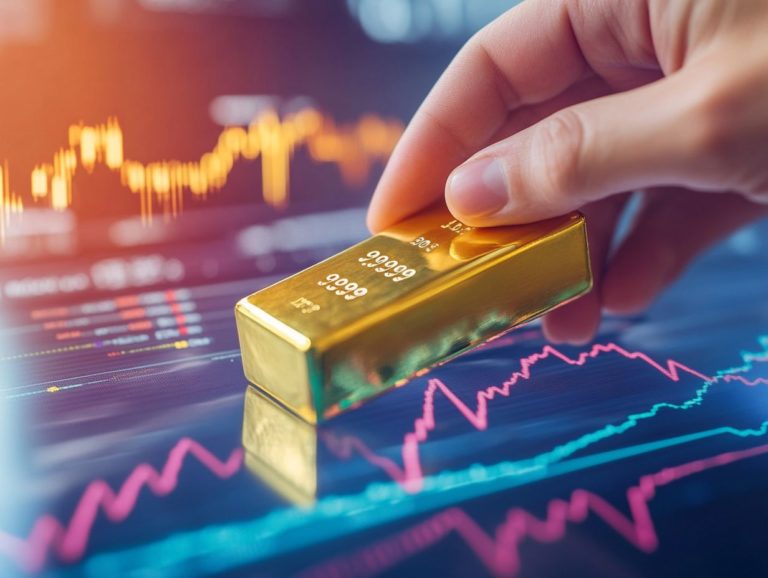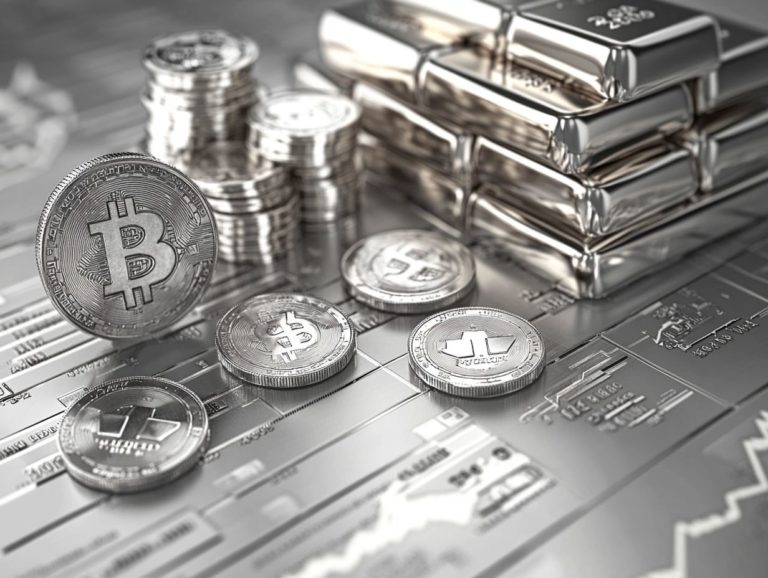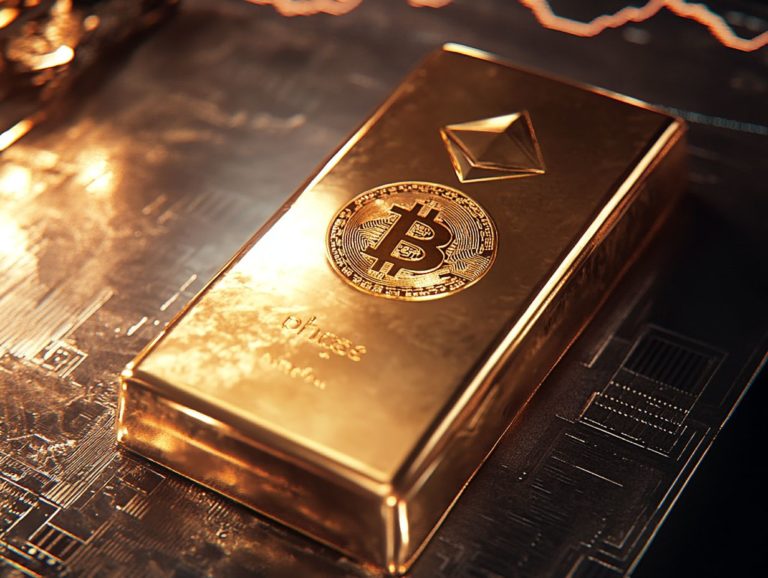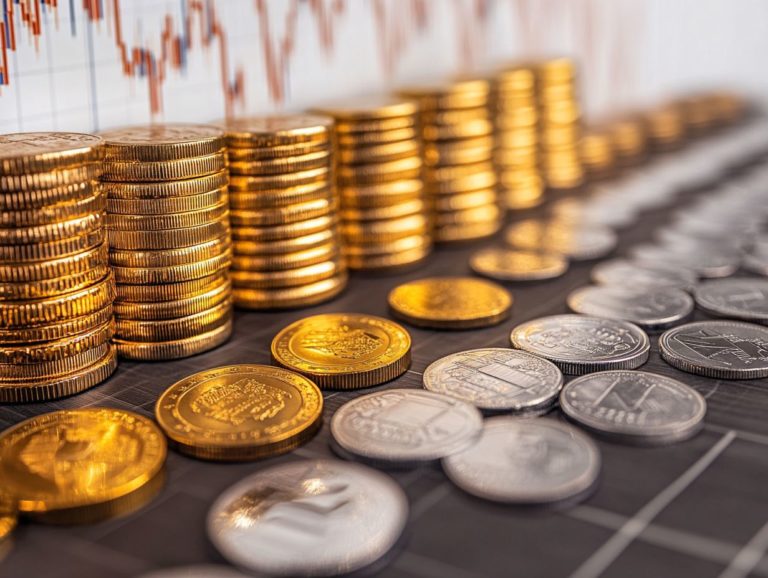Understanding Precious Metal Correlations
Navigating the realm of precious metals can be quite intricate, particularly when it comes to grasping the various factors that influence their prices.
This article delves into the complex web of precious metal correlations, illuminating the economic influences and global events that shape market dynamics.
By examining different types of correlations, from intra-market to inter-market, you can uncover how this knowledge empowers you to make smarter investment decisions.
We will explore the benefits and limitations of utilizing these correlations in your investment strategies.
Whether you re a seasoned investor or just embarking on your journey, understanding these concepts can significantly enhance your approach to the precious metals market.
Contents
- Key Takeaways:
- What are Precious Metal Correlations?
- Factors Affecting Precious Metal Prices
- Types of Precious Metal Correlations
- Using Precious Metal Correlations in Investing
- What to Watch Out For When Investing
- Frequently Asked Questions
- What are precious metal correlations?
- Why is it important to understand precious metal correlations?
- How are precious metal correlations calculated?
- What are the different types of precious metal correlations?
- Do all precious metals have the same level of correlation?
- How can I use precious metal correlations in my investment strategy?
Key Takeaways:
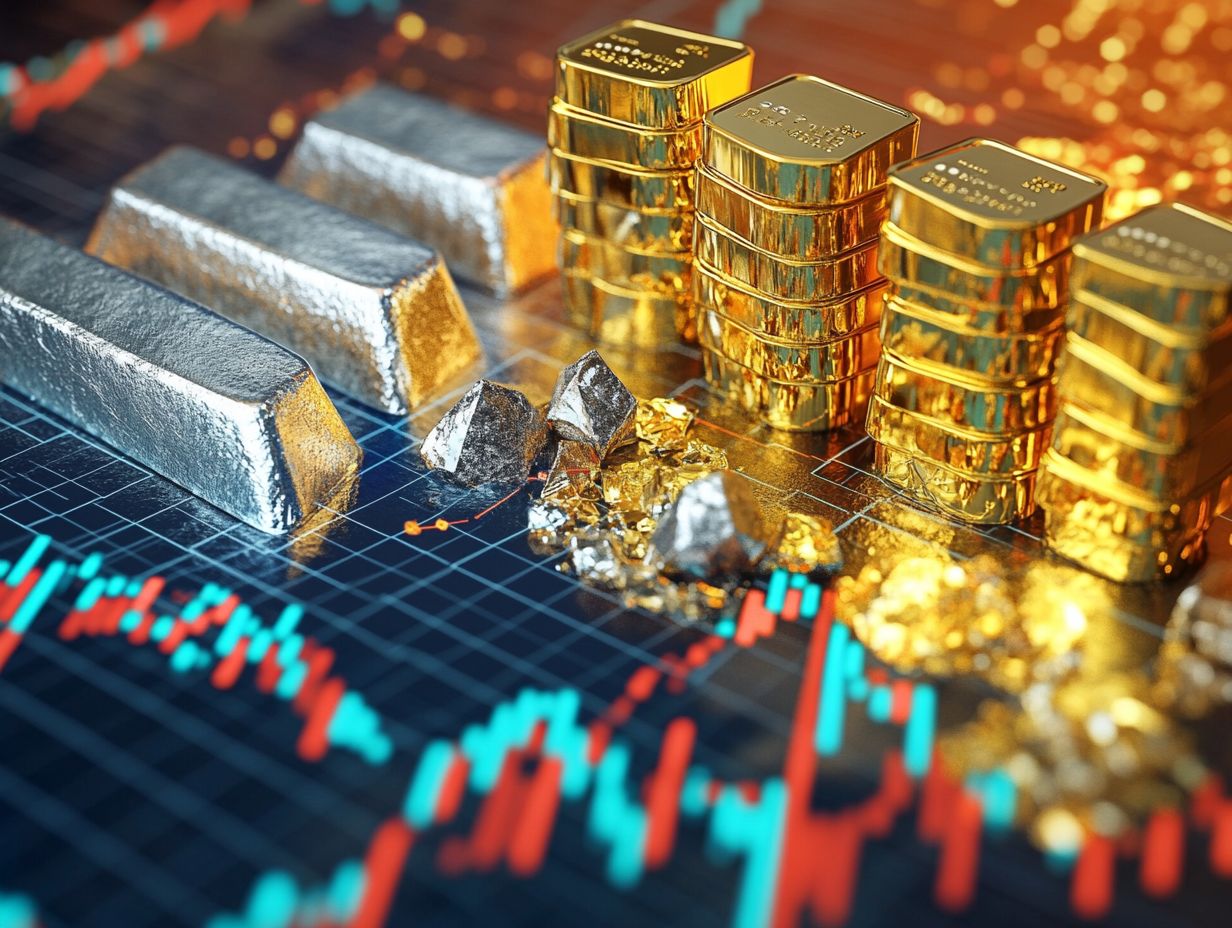
- Beyond individual market prices, precious metal correlations consider economic factors and global events for a comprehensive outlook.
- Understanding and utilizing intra-market and inter-market correlations can aid in diversification and risk management while identifying potential profit opportunities.
- While precious metal correlations provide valuable insights, consider potential inaccuracies and focus on long-term trends and predictions for more accurate investment decisions.
What are Precious Metal Correlations?
Precious metal correlations reveal the intricate relationships among various precious metals, including gold, silver, platinum, and palladium, showcasing how they respond to market dynamics like inflation and economic uncertainty.
Grasping these correlations is crucial for you as an investor seeking to build a diversified portfolio that endures market volatility and helps protect you from inflation especially during times of financial crisis or geopolitical tensions.
Factors Affecting Precious Metal Prices
Several important factors shape the prices of precious metals. Inflation, market conditions, and unique demand drivers such as investor sentiment and the monetary policies of central banks can contribute to price fluctuations in financial markets.
Understanding these dynamics empowers you to make informed investment decisions.
Economic Factors
Economic factors like inflation and overall economic uncertainty significantly influence the value of precious metals, making them an enticing option during performance drawdowns and market downturns.
As inflation chips away at your purchasing power, you may choose to invest in precious metals like gold and silver. These assets have historically maintained their value, acting as a hedge against currency devaluation.
During financial crises, these metals tend to outperform other asset classes, reinforcing their reputation as a safe haven.
Integrating precious metals into your diversified portfolio helps mitigate risks and offers potential returns when other investments stumble. Their historical resilience can give you the security and peace of mind you need to invest confidently during turbulent economic times.
Global Events and Political Climate
Global events and geopolitical tensions can profoundly impact precious metals, compelling you to consider these safe-haven assets during uncertain times. This demand drives their price movements and overall presence in financial markets.
Take the COVID-19 pandemic, for example; it triggered a notable surge in demand for gold and silver as investors sought refuge from economic turmoil and volatility.
Similarly, during the political unrest of 2008, the prevailing uncertainty drove gold prices to historic highs, illustrating how crises can create substantial fluctuations in the precious metal markets.
As an investor, you may find yourself gravitating toward these commodities, viewing them as reliable stores of value amidst instability. This tendency can lead to rapid price adjustments based on perceived risk levels and shifting market sentiment.
Types of Precious Metal Correlations
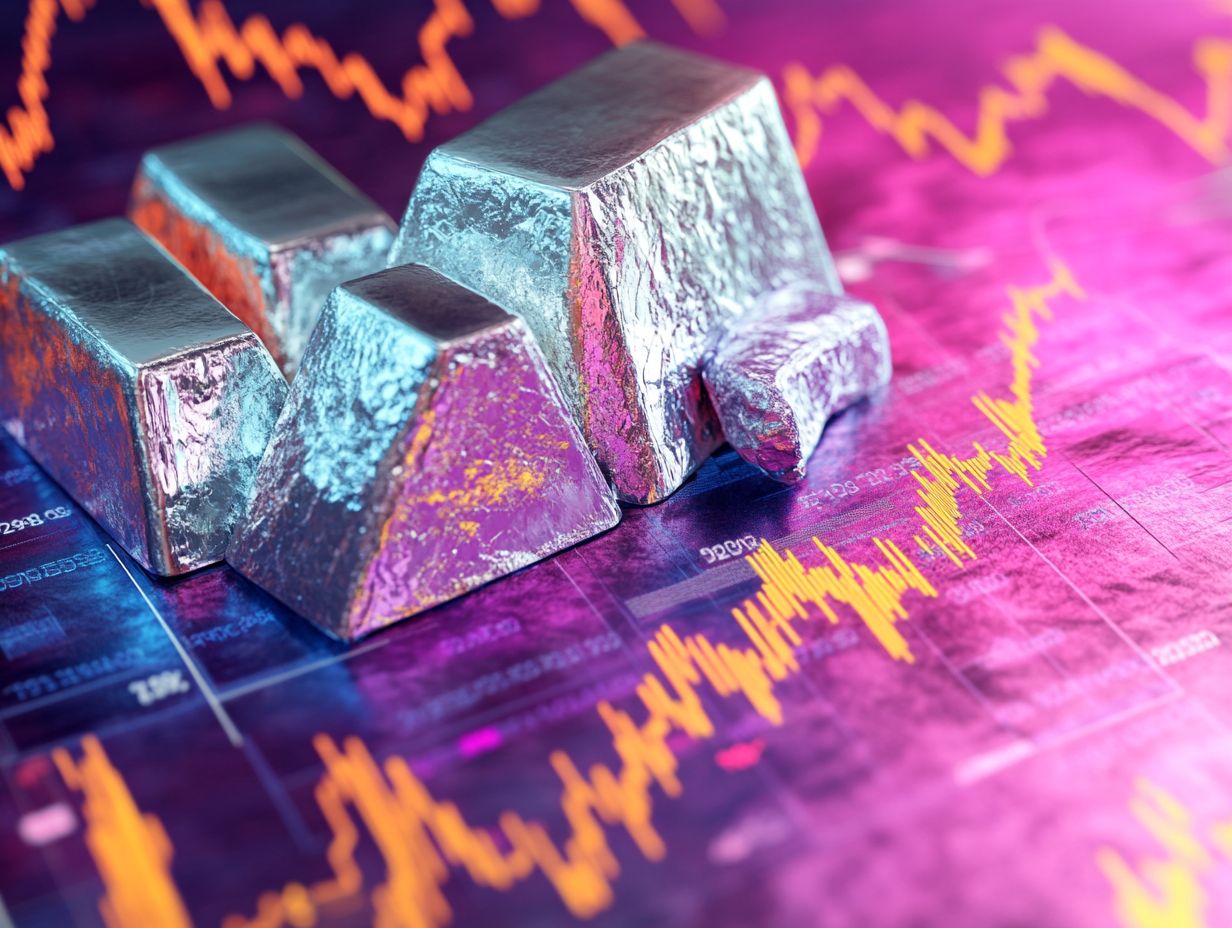
Types of precious metal correlations encompass both intra-market correlations, which highlight the relationships among metals such as gold and silver, and platinum and palladium. Additionally, inter-market correlations reveal how these metals interact with other asset classes and economic indicators.
Understanding these connections can provide valuable insights for smart investment choices.
Intra-Market Correlations
Intra-market correlations among precious metals, such as gold and silver or platinum and palladium, can provide essential insights into price movements and trends within the commodity markets. This understanding can significantly aid you in making smart investment choices.
Looking at past performance, you’ll see these metals often move together or in opposite directions, responding to various market dynamics like economic indicators, geopolitical tensions, or shifts in interest rates. For example, gold typically acts as a safe haven during times of economic uncertainty, while silver usually follows suit but is also influenced by industrial demand.
Grasping these relationships gives you the power to strategically allocate your capital across different metals, enhancing your portfolio’s diversification. Act now by recognizing the opportune moments to shift investments among correlated assets, which can potentially mitigate risks and seize emerging trends in the precious metals market.
Inter-Market Correlations
Inter-market correlations offer valuable insights into how precious metals interact with other financial assets, like equities, revealing opportunities for risk-adjusted returns within diverse investment portfolios.
Understanding these connections can greatly help you improve your portfolio performance. For example, during market downturns, equities often take a nosedive, prompting investors to seek solace in precious metals, which typically serve as a safe haven. Conversely, when stock markets are on the upswing, the allure of precious metals may wane, resulting in a dip in their prices.
By recognizing these patterns, you can strategically allocate your resources and seize opportunities amid the fluctuations. Diversifying your investments across both equities and precious metals not only helps you hedge against market volatility but also has the potential to enhance your overall returns.
Using Precious Metal Correlations in Investing
You can harness the power of precious metal correlations to elevate the diversification benefits of your investment strategies. By integrating these unique asset classes, you ll be better equipped to manage risk while also leveraging them as a potent hedge against inflation (protect your money’s value over time) in turbulent market conditions.
Diversification and Risk Management
Incorporating precious metals into your investment portfolio can provide significant diversification benefits and serve as an effective risk management tool, particularly during times of market volatility and economic fluctuations.
Metals like gold and silver have a remarkable tendency to retain their value or even appreciate when traditional equities are facing challenges, making them a reliable safe haven for investors like you. By allocating a portion of your assets to precious metals, you can protect yourself from potential losses stemming from stock market declines.
Consider specific strategies such as:
- Purchasing bullion
- Investing in exchange-traded funds (ETFs) that track these metals
- Exploring mining stocks
This approach not only broadens your investment horizon but also acts as a safeguard against inflation and currency devaluation. It reinforces the notion that integrating such assets is essential for achieving long-term financial stability.
Opportunities for Profit
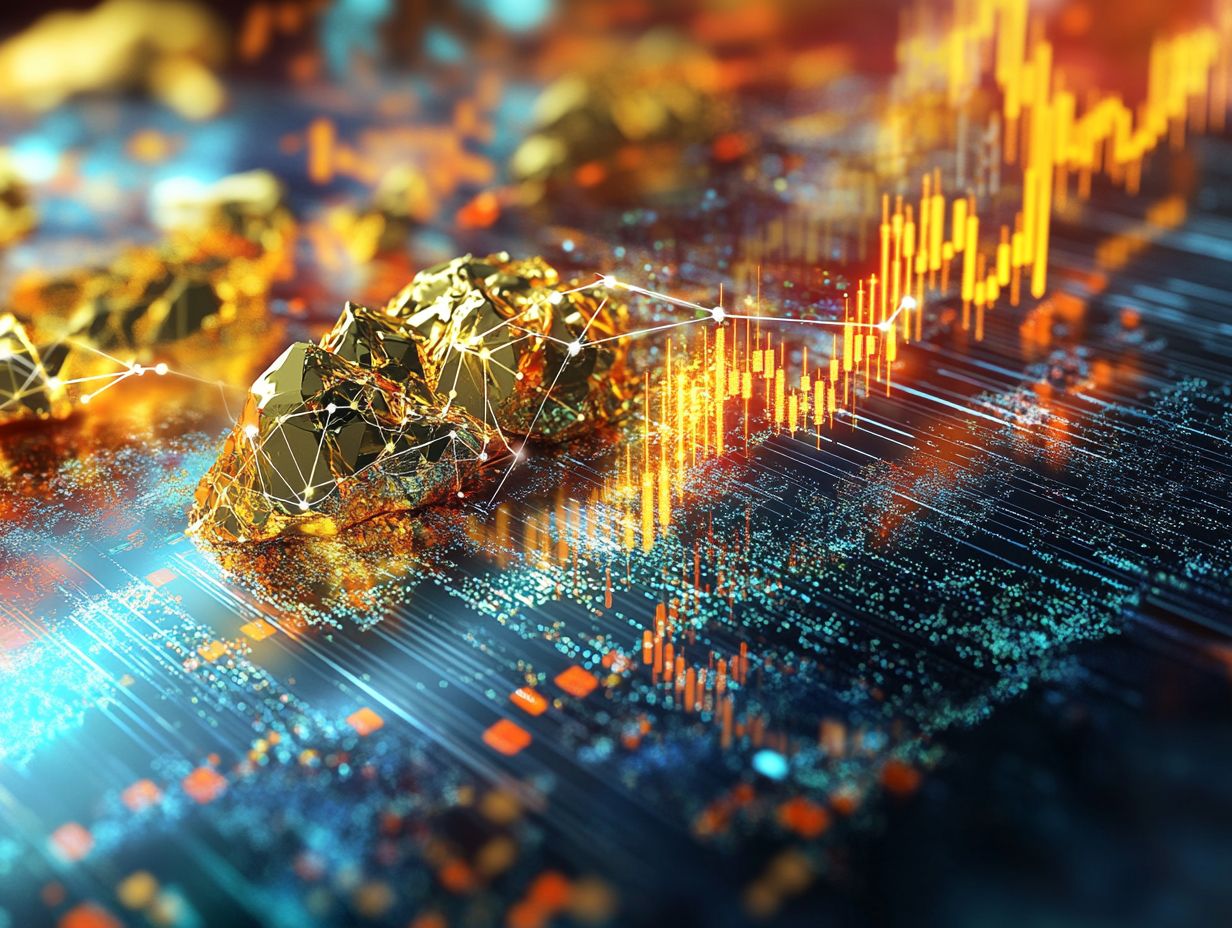
Investing in precious metals offers many opportunities for profit. You can leverage market dynamics by understanding how price movements react to economic indicators.
By analyzing historical trends and staying informed about world events that affect economies, you can enhance your timing to capitalize on market fluctuations. For instance, you ll notice that demand for gold often spikes during periods of economic uncertainty. This creates the perfect moment for savvy investors like you to step in.
Utilizing tools such as technical analysis a method of evaluating investments by analyzing statistical trends and sentiment indicators can sharpen your entry and exit points. A strategic approach could involve diversifying across multiple metals, such as silver and platinum, which may react differently to the same economic signals.
This method shows how well-informed investors position themselves strategically, anticipating market shifts with confidence and finesse.
What to Watch Out For When Investing
While you may find that investing in precious metals presents many advantages, you must be aware of the limitations and considerations before jumping in!
Be mindful of potential inaccuracies in price forecasts and the fluctuations influenced by various market dynamics.
Potential Inaccuracies and Fluctuations
Potential inaccuracies in predicting price fluctuations of precious metals can stem from unexpected economic conditions and unpredictable shifts in investor behavior. These factors ultimately influence overall market dynamics.
Consider this: sudden changes in interest rates or inflation can take analysts by surprise. This creates significant gaps between projected prices and actual outcomes. Geopolitical tensions, such as conflicts or trade disputes, often intensify this unpredictability. You might see immediate spikes or drops in metal values that don t match forecasts.
A shift in investor sentiment whether driven by fear or optimism can provoke abrupt market reactions that defy earlier expectations. Thus, staying informed through continuous market analysis is essential for navigating these complexities.
Long-Term Trends and Predictions
Analyzing long-term trends and predictions for precious metals is essential for investors like you who want to grasp future price movements shaped by inflationary pressures and broader economic growth patterns.
By diving into past performance across various economic cycles, you can uncover valuable insights into how these assets respond to shifts in financial policy, geopolitical tensions, and currency fluctuations. This analysis shows that past patterns can guide future behavior, especially as macroeconomic factors like interest rates and global demand evolve.
For anyone considering an investment in these commodities, it s crucial to understand how supply constraints (limitations in production), regulatory changes (new laws affecting the market), and technological advancements (improvements in extraction or processing) may influence pricing over time. This knowledge gives you the power to make well-informed decisions and navigate the complexities of the market with confidence.
Frequently Asked Questions
What are precious metal correlations?
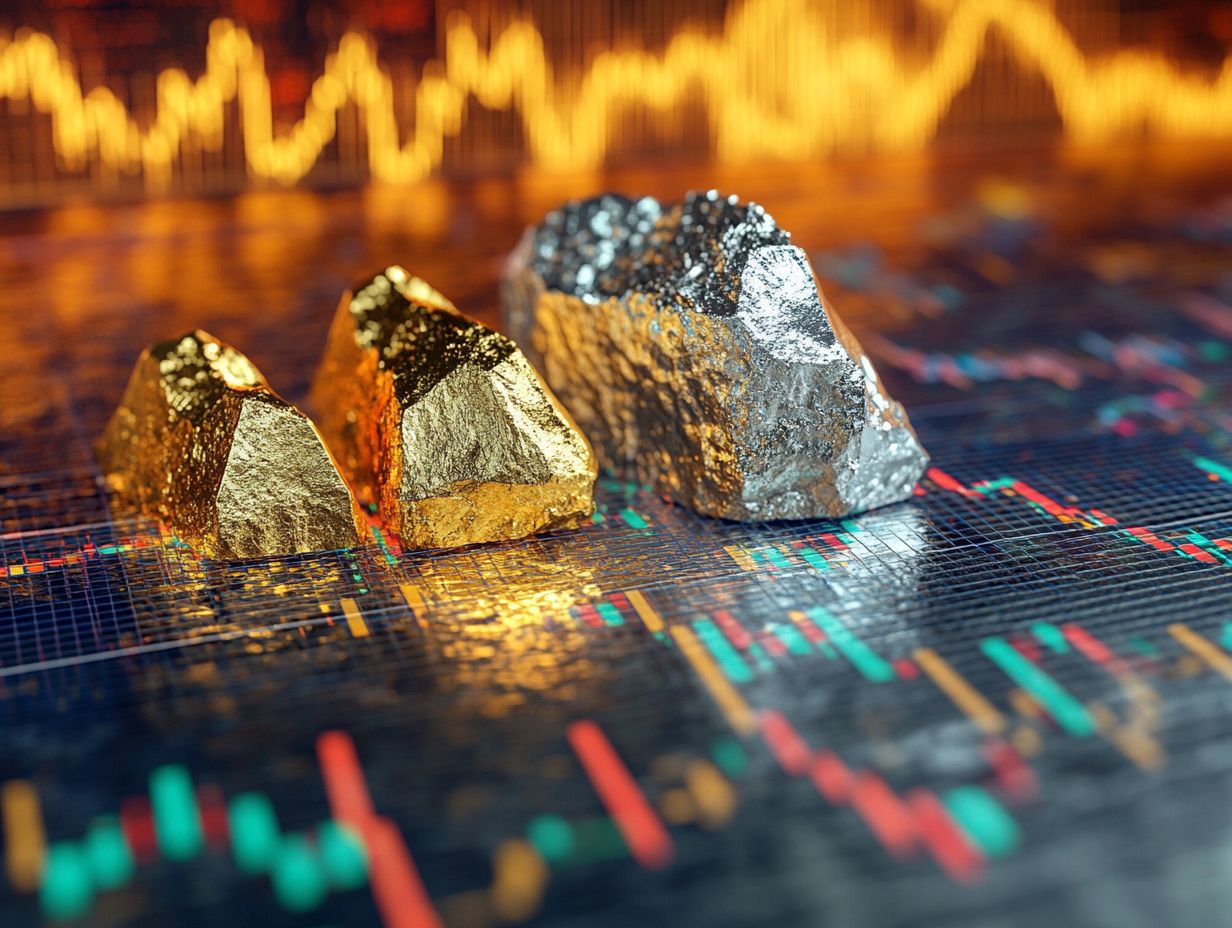
Precious metal correlations refer to the relationship between different precious metals, such as gold, silver, platinum, and palladium, in terms of price movements. This means that when one precious metal’s price goes up or down, it can affect the prices of other precious metals.
Why is it important to understand precious metal correlations?
Understanding precious metal correlations can help investors make informed decisions when diversifying their portfolios. By knowing how different precious metals move in relation to each other, investors can better manage their risk and potentially increase their returns.
How are precious metal correlations calculated?
Precious metal correlations compare the historical price movements of different metals over a specific time period.
A statistical measure shows how closely related the prices are. This can help you understand how they move together.
What are the different types of precious metal correlations?
There are two main types: positive and negative.
A positive correlation means prices move in the same direction, while negative means they move apart.
Do all precious metals have the same level of correlation?
No, they don’t. Some metals are closely related, while others might show little or no correlation.
Analyzing each metal individually is key to understanding these relationships.
How can I use precious metal correlations in my investment strategy?
You can use these correlations to diversify your portfolio and hedge against market changes.
Understanding these relationships helps you make informed decisions and manage risks effectively!










